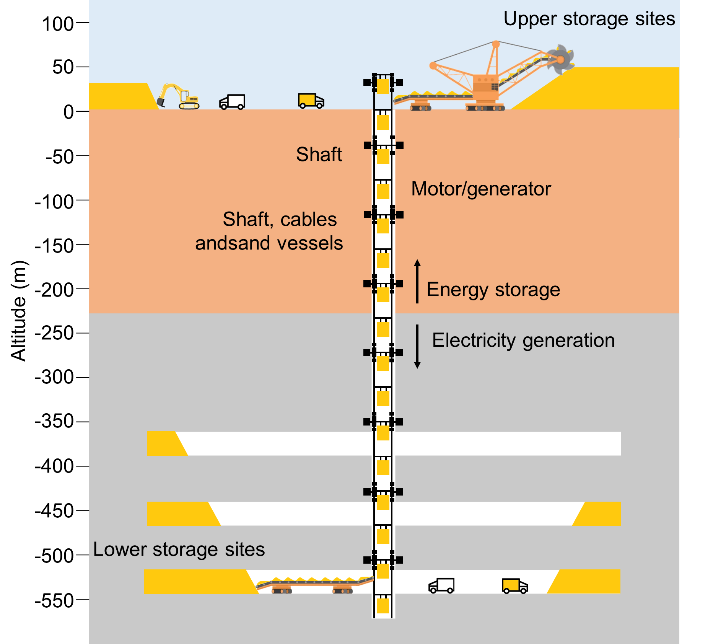The transition to a more sustainable future in terms of energy relies heavily on renewable energy sources. Finding methods to store energy effectively is essential because renewable energy sources like sunlight and wind are inherently variable and unpredictable.

Underground Gravity Energy Storage system: a schematic of different system sections. Image Credit: Hunt et al.
Batteries are the most popular and widely used form of energy storage, but there is still a need for a long-term, cost-effective solution.
An international team of researchers created a novel way to store energy by delivering sand into closed underground mines as part of a recent study led by the International Institute for Applied Systems Analysis (IIASA).
The recently developed method known as Underground Gravity Energy Storage (UGES) suggests an efficient long-term energy storage solution while also utilizing abandoned mining sites, which are likely millions in number globally.
When electricity is expensive, UGES generates electricity by lowering sand into an underground mine, converting the sand’s potential energy into electricity through regenerative braking, and then lifting the sand from the mine to an upper reservoir using electric motors to store energy.
The shaft, motor/generator, upper and lower storage sites, and mining machinery make up UGES’ main parts. More power can be extracted from the plant by widening and deepening the mineshaft, and the mine’s size affects the plant’s ability to store energy.
When a mine closes, it lays off thousands of workers. This devastates communities that rely only on the mine for their economic output. UGES would create a few vacancies as the mine would provide energy storage services after it stops operations. Mines already have the basic infrastructure and are connected to the power grid, which significantly reduces the cost and facilitates the implementation of UGES plants.
Julian Hunt, Study Lead Author and Researcher, Energy, Climate, and Environment Program, International Institute for Applied Systems Analysis
Batteries and other energy storage devices experience long-term energy loss due to self-discharge. The sand serves as the energy storage medium for UGES, preventing energy loss due to self-discharge and allowing for extremely long energy storage times of up to several years.
The investment costs of UGES range from $1 to $10/kWh, and the cost of power capacity is $2.000/kW. The global potential for the technology is estimated to be between 7 and 70 TWh, with the majority of this potential concentrated in China, India, Russia, and the USA.
To decarbonize the economy, we need to rethink the energy system based on innovative solutions using existing resources. Turning abandoned mines into energy storage is one example of many solutions that exist around us, and we only need to change the way we deploy them.
Behnam Zakeri, Study Co-Author and Researcher, Energy, Climate, and Environment Program, International Institute for Applied Systems Analysis
Journal Reference
Hunt, J., et al. (2022) Underground Gravity Energy Storage: A Solution for Long-Term Energy Storage. Energies. doi:10.3390/en16020825.